Here is a link to our website as well: https://taloslightningdetectors.com/
Dan Gibson | Channel Manager | Talos Lightning Detectors
d. 727.475.6019 | c. 859.630.5528 | dan_gibson@taloslightningdetectors.com | taloslightningdetectors.com
ScioSense Technology Center
| Quick recap | |
| The meeting revolved around discussing the locations and future plans of various participants. The conversation also focused on the importance of lightning detection, especially on boats, and the introduction of the Talos lightning situational device. The team also discussed the installation process and power requirements of the device. Towards the end, the team explored the possibility of a lightning insurance policy for boat owners. | |
| Summary | |
| Boat Locations and Plans Discussed | |
| The meeting involved a discussion about the current locations and plans of various participants. COSMOS shared that they were in Manzanillo Fredina until February 3rd and had issues with their boat’s fridge, which they decided to replace. Jerry Norton reported that they were still working on fixing some issues on their boat based in Shelter Bay, with plans to sell out by the end of the week. Jonathan Durning mentioned they had recently arrived in Puerto Penasco with their boat and had a list of tasks to complete. Dan Gibson, the Channel Sales Manager for the Talos Lightning Detector Line, joined the meeting from Florida and shared his experience in setting up sales networks for electronic companies. He also discussed the product’s applications in various industries. The meeting also touched upon the topic of lightning detection, with Scott B sharing that his boat had been hit by lightning three weeks ago and he was currently in Tahiti rewiring it. Torsten Schulz stated he was still in the motherland for another week or so, then heading south. Chris Glubka reported a small low-pressure system passing overhead with some lightning, while they were in Fiji. | |
| Talos Lightning Situational Device Presentation | |
| Dan Gibson introduced the Talos lightning situational device, developed by Precision Measurement Technologies in Clearwater, Florida. The device uses technology originally designed for lightning detection in cell phones. However, due to electromagnetic interference, it was adapted into an OEM and aftermarket unit with a variety of applications. The audience was encouraged to ask questions throughout the presentation. The session ended with a demonstration of the product in operating and demo modes. | |
| Lightning Safety: Facts and Risks | |
| Dan Gibson provided several facts about lightning, emphasizing the danger of being struck by lightning which can occur even when the weather seems benign. He shared that an average of 6,000 people are struck by lightning annually, resulting in approximately 40 deaths and 400 injuries in the United States alone. Dan also highlighted the risk to boats, citing a study that showed a 1 in a thousand chance of a boat being struck each year, with Florida being particularly susceptible. | |
| Lightning Detection System for Boats Discussed | |
| Dan Gibson discussed the importance and functionality of a lightning detection system, particularly for use on boats. He highlighted that the system is self-contained and does not require a cellular connection, unlike other apps. The system operates on boat power or 4 double A batteries and has different models for varying boat sizes. The system alerts users based on their exact location and time of the lightning strike. Dan also mentioned that the units are waterproof and can be installed on multiple vehicles, including boats, golf carts, and pools. He emphasized that the system should be part of every boat’s safety checklist. | |
| Lightning Detector and Safety Plan | |
| The team discussed a device that detects lightning, with Dan explaining its standalone operation through a unique electromagnetic pulse without needing an internet connection or connection to a weather station. Scott B emphasized the importance of a plan for dealing with lightning strikes, suggesting quick action such as grounding boats and disconnecting electronics. Panama proposed creating a working group to develop best practices for handling lightning strikes, a proposal backed by Dan and Chris, who shared a recent incident of a lightning strike. | |
| Lightning Detector Installation and Power Requirements | |
| Dan Gibson explained the installation process for a lightning detector on a sailing boat, stating that it could be positioned to face the sky, but doesn’t require a clear line of sight. He also clarified that the device comes in different configurations and prices, with the OEM unit costing between $2,320 for a single indicator to $550 for a splitter cable and two indicators. Panama from the South Pacific Atlantic POSSE inquired about mounting the device inside, which Dan confirmed was possible. He also clarified that the button or light of the device needs to be exposed. There was a discussion about the power requirements of the device, with Jonathan Durning asking about the power consumption. Dan responded that the device needs between 6 and 30 volts, but he wasn’t sure about the specific power usage. Panama mentioned that a standalone unit with 4 double A batteries lasts about a year and a half in Florida, which Dan confirmed. Dan promised to provide the exact power usage details at a later time. | |
| Lightning Insurance Policy for Boat Owners | |
| The team discusses the potential benefits of a lightning insurance policy for boat owners, focusing on discounts for those who have detectors and power switch companies working with them. Dan Gibson mentions that they are working with insurance companies to offer discounts for people with detectors on their boat. Jerry Norton emphasizes the importance of having a consistent awareness of the need for a plan and circulating those plans. The team also discusses a boat that burned itself out due to a lightning strike, with one person not on board when he came back after a vacation. | |
| Next steps | |
| • Dan will provide a 15% discount promo code for Panopol Posse members if they decide to buy a unit from the Talos Lightning Detectors website. | |
| • Dan will provide information on the power usage of the OEM unit. | |
| • Panama will create a working group to develop a document on best practices for dealing with lightning strikes. |
FROM BOAT TEST
“Lightning is one of the most common threats to a boater on the water. The odds of dying from lightning while at sea are 1 in 161,856 compared to 1 in 3,748,067 for a shark attack. So is it worth investing $ into a device that can help keep you apprised of potential lightning strikes, especially when our very own Capt. Steve positively tested it? We think so and it’s called the Talos Lightning Strike Detector SFD-1000 series.
Easy to Use
The SFD-1000 can recognize a lightning strike from up to 25 miles away. It has an algorithm that can detect false signals and the best thing is that works with color-coding, so all it takes is a glance when it starts flashing. If the unit flashes green, it has detected a strike 25 miles away. It also sounds like an audible beep. As lightning gets closer, the SFD-1000 flashes blue when it detects a strike 16 miles away and sounds two audible beeps. Red flashing and three audible beeps indicate that lightning is only 6 miles away and a boater should head for cover if he/she hasn’t already done so. There is a reminder label right on the detector.
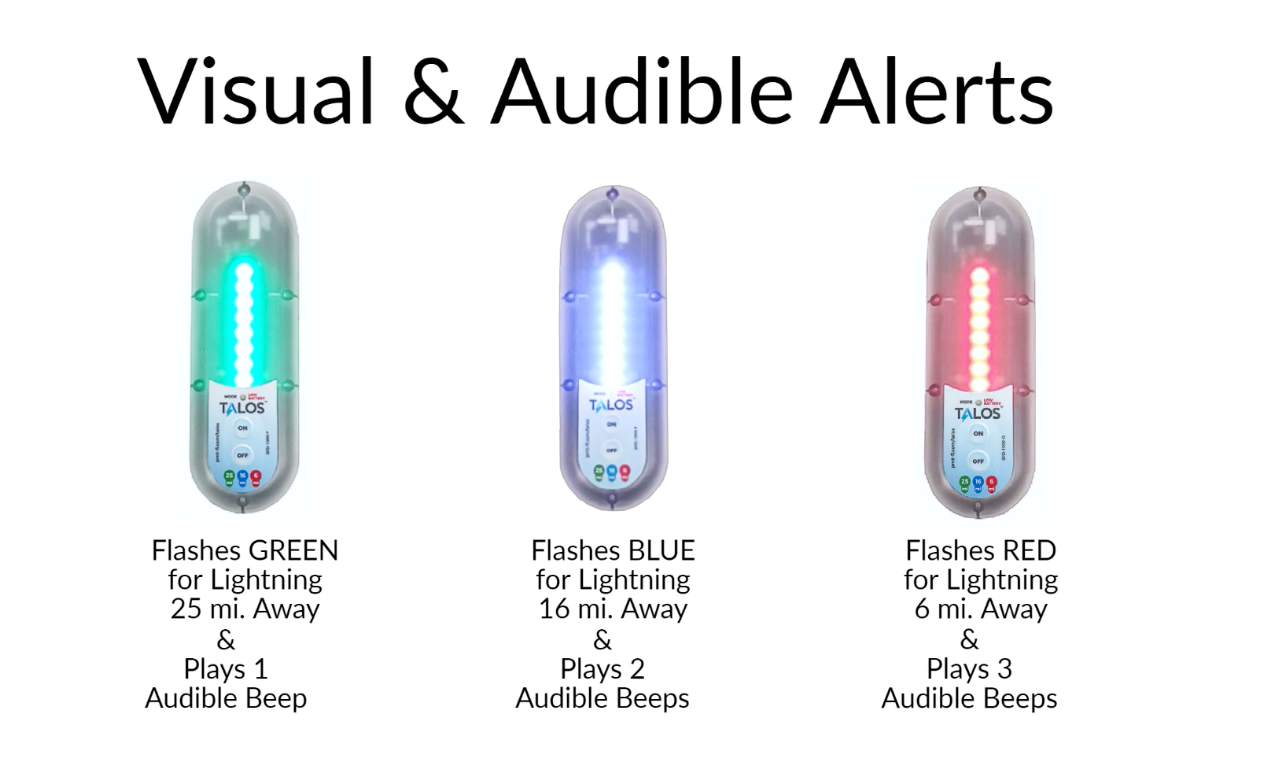
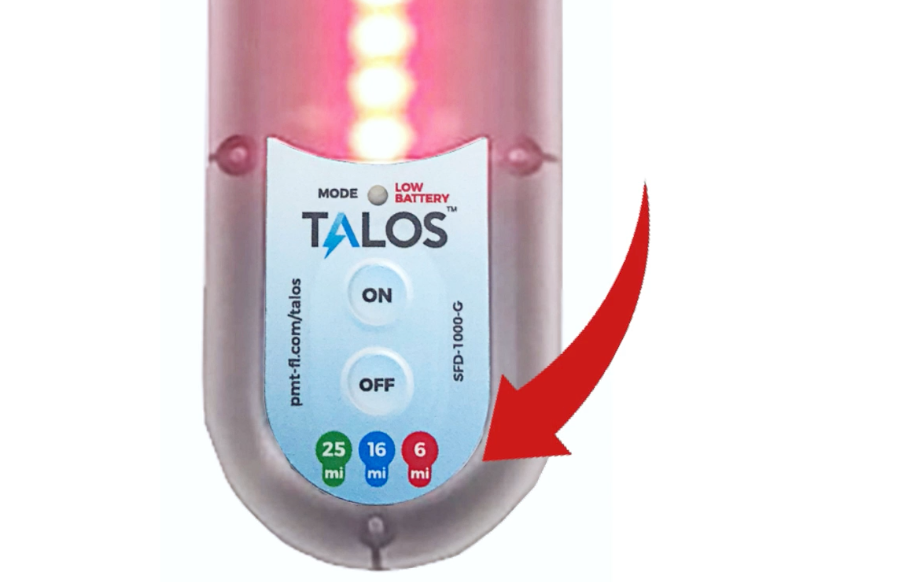
Compact Size
At 7.5” long by 2.5” wide (19.05 cm by 6.35 cm) for the unit and 2.92” (7.41 cm) for the base and 2.17” (5.51 cm) tall, the unit is small enough that it could be mounted on a kayak or paddleboard. The Talos Lightning Strike Detector provides situational awareness of lightning and works in real-time. No cellular signal is required and there are no subscription fees. It’s IP-65 waterproof and is available as a hard-wired unit or with four AA batteries. Lithium is recommended and Talos says the average battery life is one year.
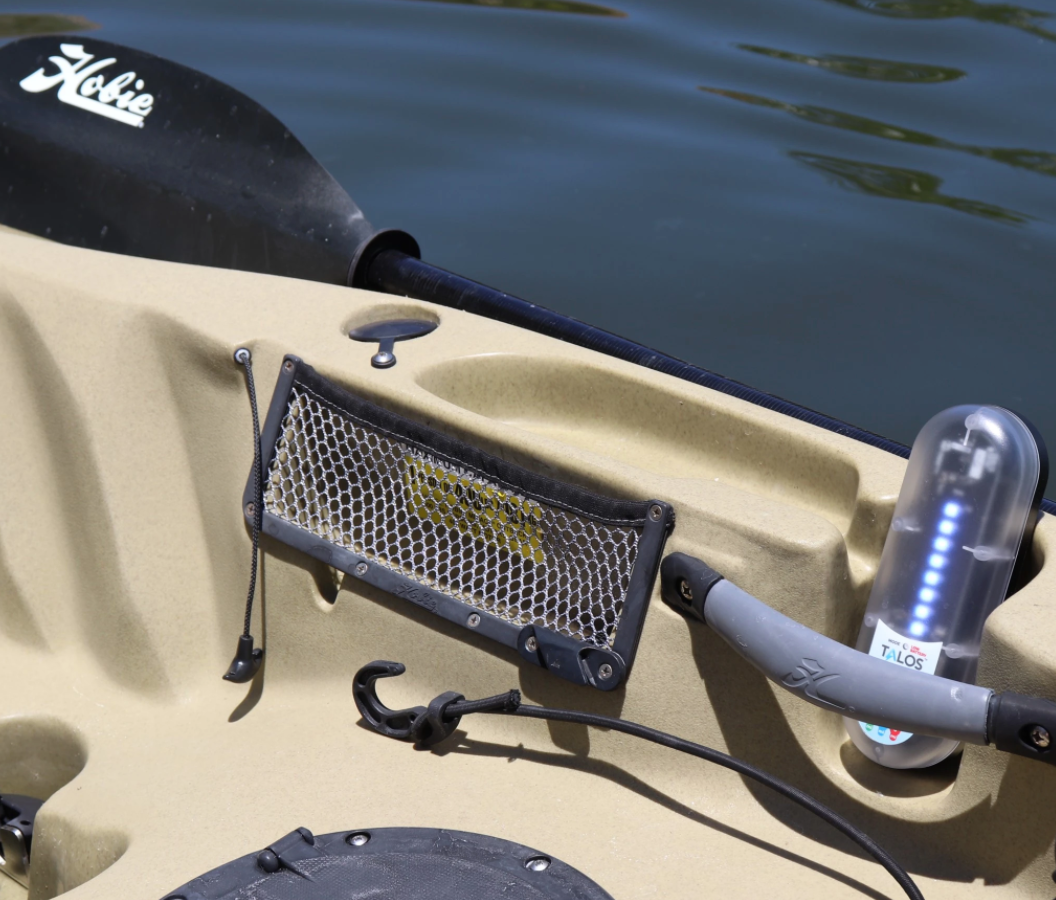
The SFD-1000 should be installed with the lens facing skyward for best results and it should be placed where the temperature does not exceed the specified limits for a boat’s battery. It should be installed a minimum of 3’ (0.91 m) from cellphones, wearables and other equipment that emits electrical noise. If the SFD-1000 can’t detect lightning due to electrical noise, it will display a sequence of all three colors on the top 3 LEDs. It needs to be relocated.
When the unit is first powered up, it’s in Normal mode and actively listens for lightning/storm activity. Press the On button a second time and it goes into auto-sleep mode. The detector sleeps until activity is detected. Then it turns on. If no weather is detected for 30 minutes, it goes back to sleep.
Three Versions
There are three versions of the SFD-1000. The base unit is for permanent installation in a single location and costs $139 retail. The SFD-1000 RS looks like a rocker switch and fits into the standard spot for one in a switch panel. Install the SFD-1000 remotely and the switch replacement flashes the color when a strike is detected. The SFD-1000 R is round and operates identically to the RS with a small puck-like indicator that mounts to a boat’s dash or wherever an owner wants. Extra indicators are also available for installation at multiple helm stations. Boatbuilders including Bass Cat and Bertram are installing the Talos products on new models.
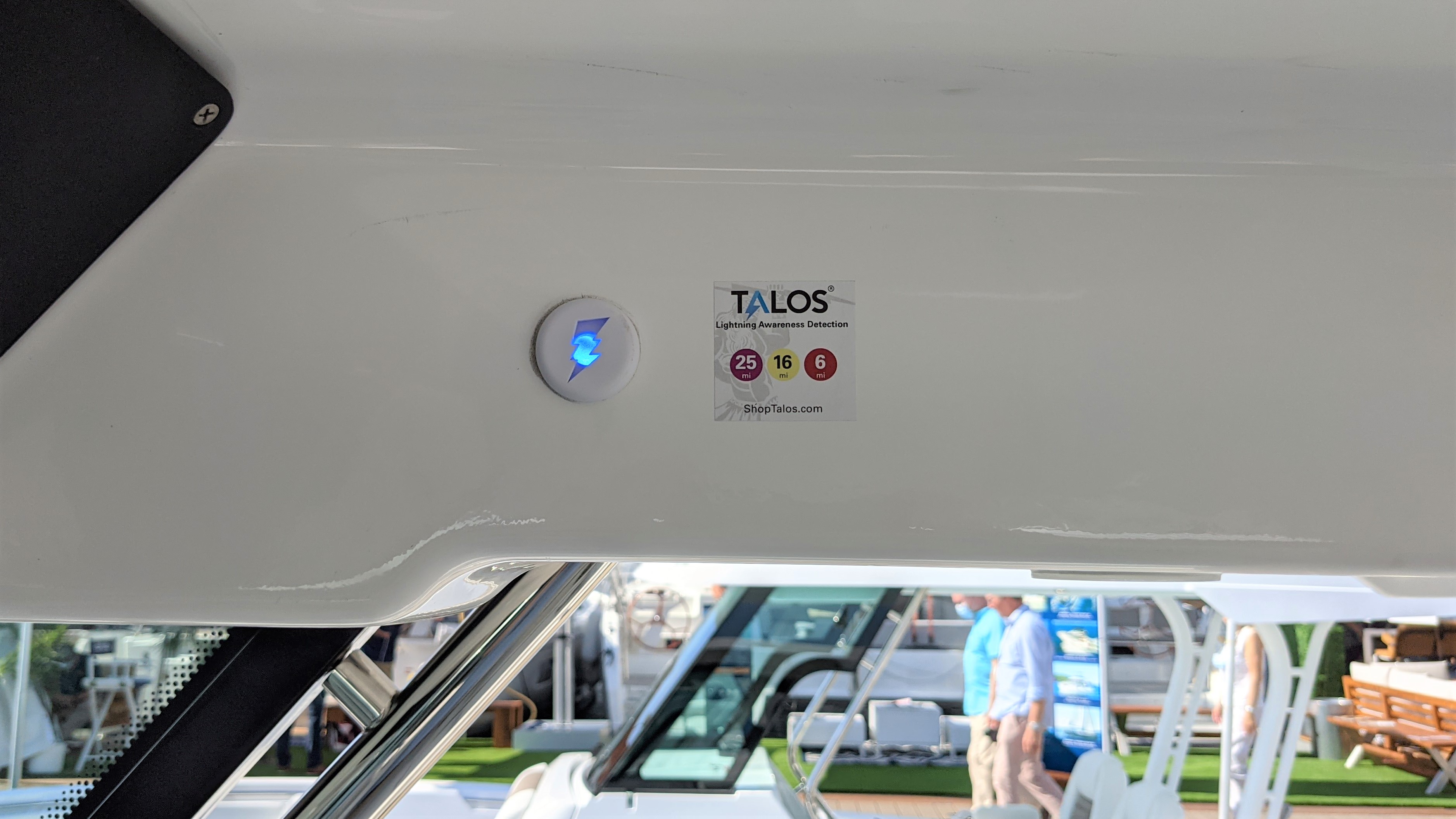
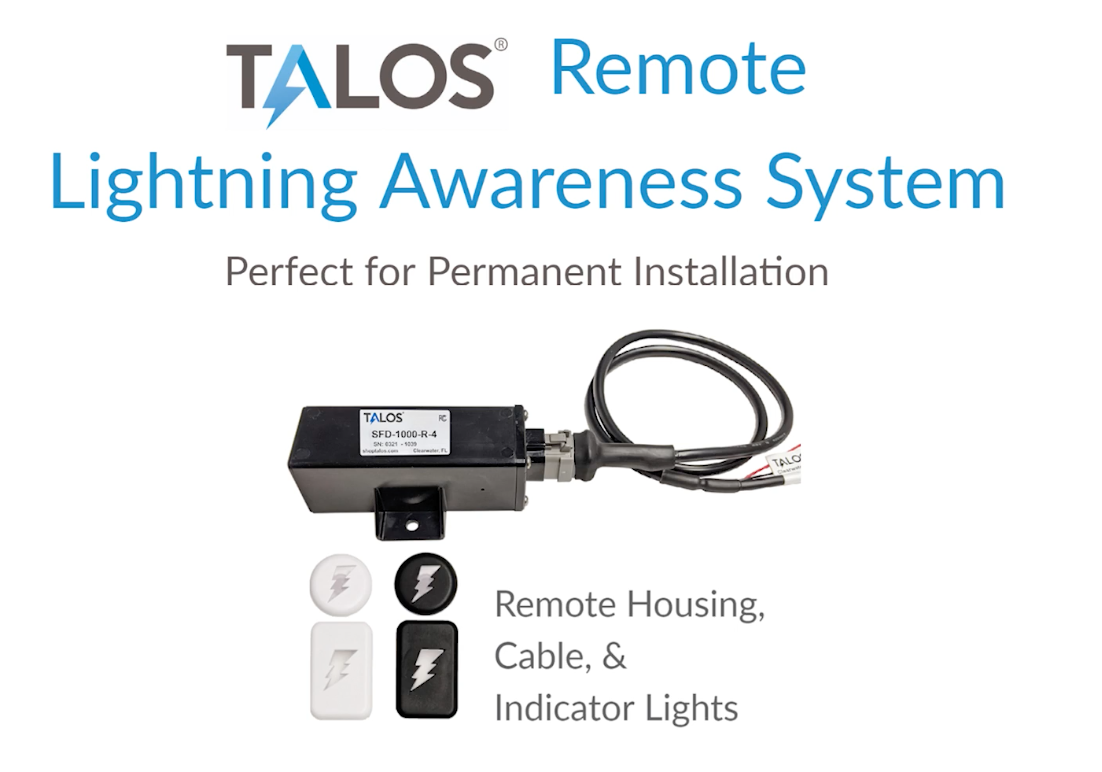
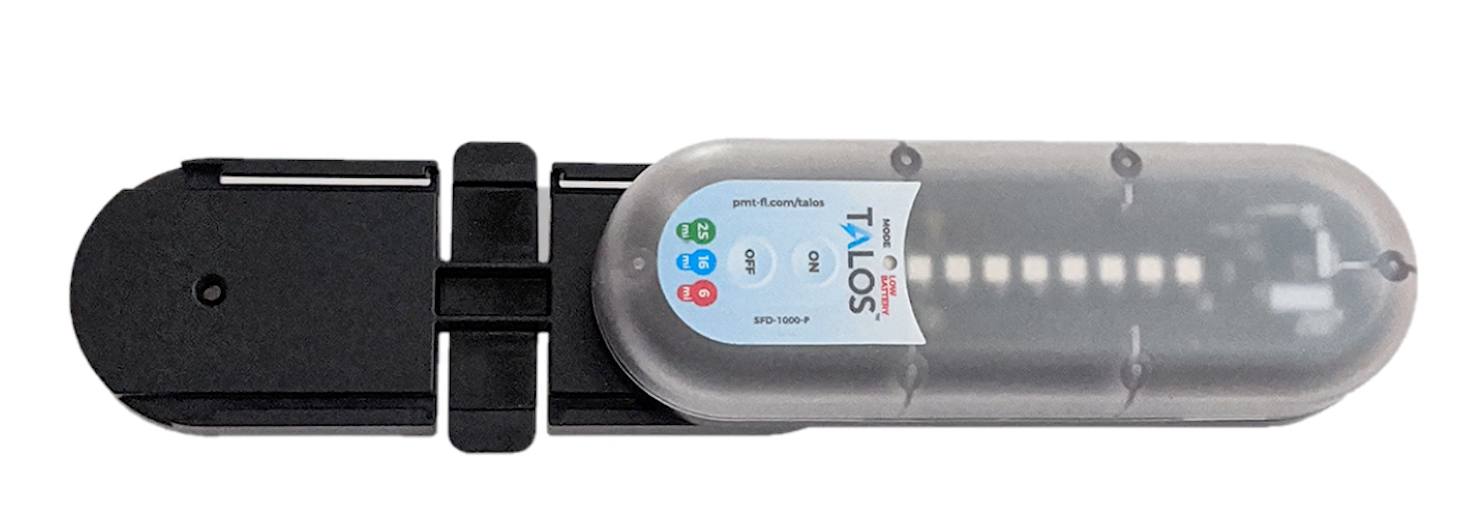
Real-World Test
Capt. Steve, BoatTEST’s director of testing and resident tech-head, evaluates the SFD-1000 using SiriusXM weather and a popular weather app for aviation as backup. With a storm approaching, the SFD-1000 indeed began flashing green with the first lightning strike 25 miles away. A little while later, the flashing changed to blue with the audible beeps indicating the approaching front was 16 miles away. If we had been out on the water, it would have been time to head to shore. As a storm closes in, it often picks up speed and it wasn’t long before we heard three beeps and the SFD-1000 flashed red.
Observations
Thunder can only be heard from 10 miles away, but lighting can actually strike when a storm is as far away as 25 miles. That’s why the Talos Lightning Strike Detector is worthwhile, especially for the cost of $139. Lightning ranks second as a cause of weather-related injuries and fatalities. The SFD-1000 was nominated for an Innovation Award at the 2021 Storm Expo.
There are numerous benefits to the SFD-1000 for boaters, especially fishermen and long-range cruisers. It works in the background and stays on. It needs no attention to keep a user apprised with real-time data. Comparatively, an app or a chartplotter needs to be changed to the proper mode to provide the information. For the cost of a dinner date at a good restaurant, a boatowner can enhance his/her family’s safety. “
